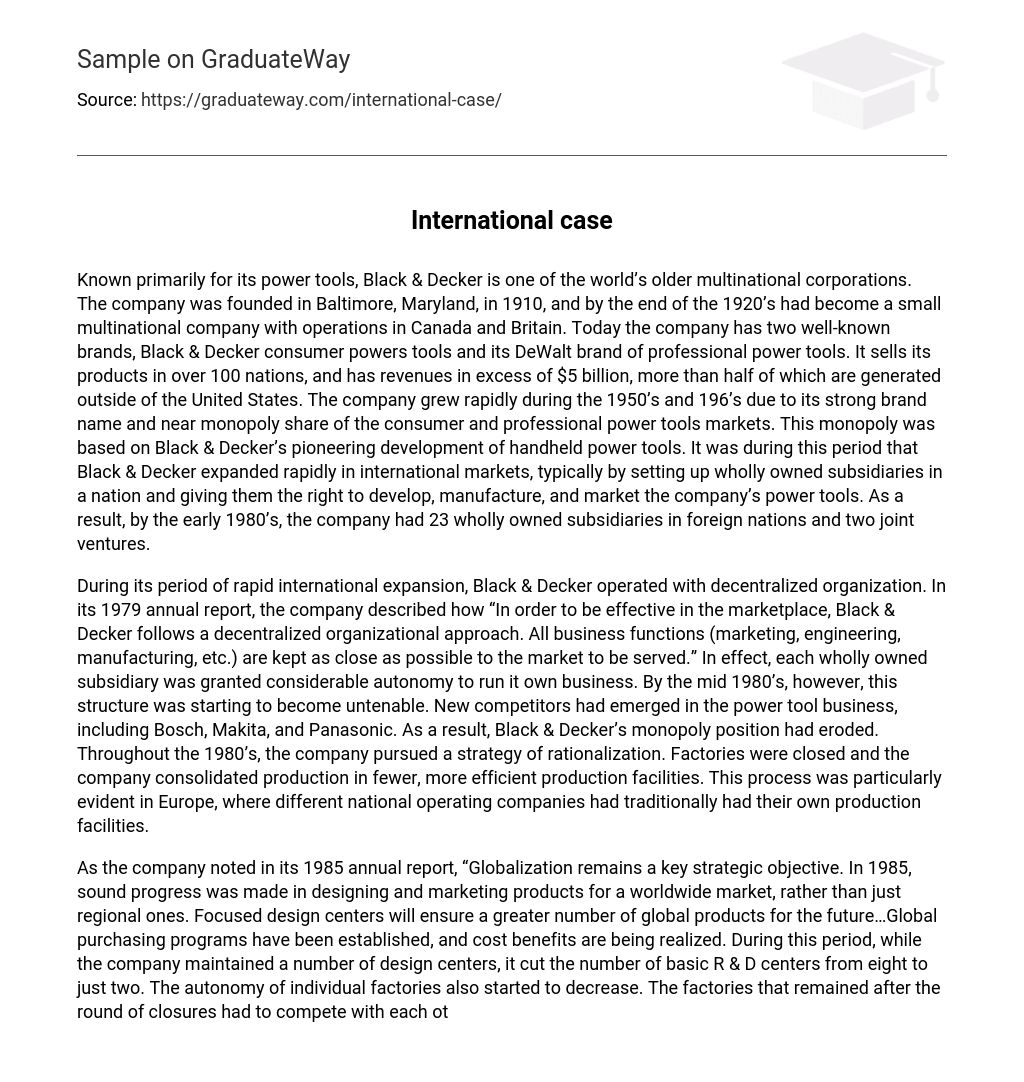Black & Decker, a renowned multinational organization, has gained recognition primarily for its power tools. Originating in Baltimore, Maryland in 1910, the company had already established itself as a small multinational firm by the late 1920s, operating in Canada and Britain. Presently, Black & Decker possesses two well-known brands in the market: Black & Decker consumer power tools and its professional power tools line called DeWalt. With a global presence spanning over 100 countries, the company generates revenues exceeding $5 billion, of which over half originate from international markets. The company experienced substantial growth during the 1950s and 1960s, fueled by its dominant brand and near-monopolistic position within both consumer and professional power tool markets. This market dominance was achieved through Black & Decker’s pioneering efforts in handheld power tool development. As a consequence, the company rapidly expanded its international presence during this era by establishing wholly owned subsidiaries in various nations, enabling them with rights to develop, manufacture, and market Black & Decker’s power tools. Consequently, by the early 1980s, the company amassed 23 wholly owned subsidiaries across different countries as well as two joint ventures.
During its period of rapid international expansion, Black & Decker operated with a decentralized organization. In its 1979 annual report, the company explained that it followed a decentralized organizational approach to be effective in the marketplace. All business functions, such as marketing, engineering, and manufacturing, were kept close to the market they served. Wholly owned subsidiaries were given autonomy to run their own business. However, by the mid 1980’s, this structure became untenable due to the emergence of new competitors like Bosch, Makita, and Panasonic in the power tool industry. As a result, Black & Decker’s monopoly position declined. In the 1980s, the company adopted a rationalization strategy which involved closing factories and consolidating production in more efficient facilities. This streamlining process was particularly noticeable in Europe, where each national operating company used to have their own production facilities.
According to the company’s 1985 annual report, the objective of globalization was emphasized. Progress was made in designing and marketing products for a global market rather than just regional markets. Focused design centers were established to increase the number of global products in the future. Global purchasing programs were implemented and cost benefits were seen. As part of these changes, the number of basic R&D centers was reduced from eight to two, and the autonomy of individual factories decreased. Remaining factories had to compete for the opportunity to produce products for the global market. Decisions regarding production for world markets were now being made by managers at corporate headquarters. Despite this, national subsidiaries still maintained some autonomy. If a subsidiary developed a new product, it was likely to be given the responsibility of producing it for the global market. Additionally, if a subsidiary performed well, corporate management would generally not interfere.
By the 1990’s, it was evident that the previous change was insufficient. The power tools market faced additional price pressure from retailers like Home Depot and Lowe’s. In response, Black & Decker sought greater manufacturing efficiencies. They closed more factories in established subsidiaries and began relocating production to new facilities in Mexico and China. This resulted in diminished autonomy for local factory managers. Corporate managers became more aggressive in product allocation based on operating costs. Consequently, Black & Decker’s factories had to compete for production rights, leading to closures of underperforming factories. In 2001, Black & Decker announced another restructuring initiative. The workforce was reduced by 700 people to 4,500, established factories in the United States and Britain were shut down, and production was redirected to cost-effective facilities.
In 2004, Black & Decker reorganized its power tools business into two global divisions. One division focused on the development, manufacture, and marketing of Black & Decker power tools, while the other division focused on the same for the company’s professional DeWalt brand. The company had a total of 36 manufacturing facilities, with 18 located outside the United States in Mexico, China, the Czech Republic, Germany, Italy, and Britain. Additionally, it had seven design centers and two R&D centers, one in the United States and one in Britain.
The design and R&D centers in the United States and Britain took on the responsibility of developing new products for the global market. As time went on, production was increasingly allocated to factories in China, Mexico, and the Czech Republic. In its 2004 annual report, Black & Decker mentioned that this trend was likely to continue.
Please submit your assignment by clicking on the link in the Assignments folder under Course Information. Your assignment should include responses to the questions below, using information from the text, outside research, and class discussions.
Case Discussion Questions
During the 1950’s and 1960’s, Black & Decker pursued international expansion by employing strategic approaches outlined in CAPSIM. The company had a particular strategy and operated with a distinct international organization structure during this time. Given the competition at that time, it is important to consider if Black & Decker’s strategy and structure were appropriate.
During the 1980’s and 1990’s, the competitive environment faced by Black & Decker experienced alterations. In response to these changes, Black & Decker implemented modifications in both its strategy and structure to enhance its competitiveness.
By the 2000’s, Black & Decker was pursuing a strategy in the global marketplace. The structure of this strategy can be characterized by examining whether it fit the strategy and environment.
4. What factors do you believe contributed to the nearly twenty-year delay in Black & Decker implementing a change in their strategy and structure? Additionally, could the implementation of a balanced scorecard approach have assisted Black & Decker in this process?





